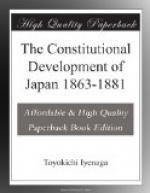Sir Harry Parkes was right when he told the Earl of Clarendon that “the establishment of such an institution (the Kogisho) formed one of the first objects of the promoters of the recent revolution."[10]
The Kogisho was opened on the 18th of April, 1869,[11] and the following message[12] from the throne was then delivered:
“Being on the point of visiting our eastern capital, we have convened the nobles of our court and the various princes in order to consult them upon the means of establishing the foundations of peaceful government. The laws and institutions are the basis of government. The petitions of the people at large cannot be lightly decided. It has been reported to us that brief rules and regulations have been fixed upon for the Parliament, and it seems good to us that the House should be opened at once. We exhort you to respect the laws of the House, to lay aside all private and selfish considerations, to conduct your debates with minuteness and firmness; above all things, to take the laws of our ancestors as ‘basis,’ and adapt yourselves to the feelings of men and to the spirit of the times. Distinguish clearly between those matters which are of immediate importance and those which may be delayed; between things which are less urgent and those which are pressing. In your several capacities argue with careful attention. When the results of your debate are communicated to us it shall be our duty to confirm them.”
The Kogisho was composed mostly of the retainers of the Daimios, for the latter, having no experience of the earnest business of life, “were not eager to devote themselves to the labors of an onerous and voluntary office.” Akidzuki Ukio No Suke was appointed President of the Kogisho.
The object of the Kogisho was to enable the government to sound public opinion on the various topics of the day, and to obtain the assistance of the country in the work of legislation by ascertaining whether the projects of the government were likely to be favorably received.
The Kogisho, like the Councils of Kuges and Daimios, was nothing but an experiment, a mere germ of a deliberative assembly, which only time and experience could bring to maturity. Still Kogisho was an advance over the council of Daimios. It had passed the stage resembling a mere deliberative meeting or quiet Quaker conference, where, for hours perhaps, nobody opens his mouth. It now bore an aspect of a political club meeting. But it was a quiet, peaceful, obedient debating society. It has left the record of its abortive undertakings in the “Kogisho Nishi” or journal of “Parliament.” The Kogisho was dissolved in the year of its birth. And the indifference of the public about its dissolution proves how small an influence it really had.
But a greater event than the dissolution of the Kogisho was pending before the public gaze. This was the abolition of feudalism, which we shall consider in the next chapter.




